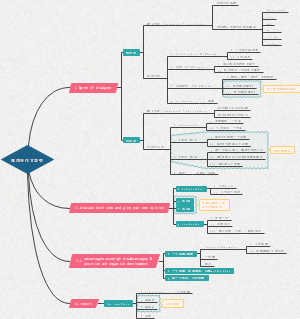导图社区 Speech sounds语言思维导图
- 56
- 0
- 0
- 举报
Speech sounds语言思维导图
这是一篇关于Speech sounds语言思维导图,包含语言学、音韵学、最小对立体测试,语音产生和音标等。
编辑于2023-11-14 12:54:13- 语言学
- 音韵学
- 相似推荐
- 大纲
Speech sounds
Phonetics
Speech production and phonetic transcription
Speech production 发音
Speech organs 发音器官
Trachea 气管
顶端为
Larynx 喉
Vocal folds 声带
横卧结构(前段相连,后端分离)
三种状态
Apart 分离
产生
Voiceless consonants 清辅音「p,s,t」
Close together 贴近
产生
Voiced 浊辅音「b,z,d」
Totally closed 紧闭
产生
Glottal stop 声门爆破音
前段为
Adam’s apple 喉结
Lung 肺
发音以气流作为能量来源,多数情况下气流来自于肺部
Three cavities of the vocal tract 声道的三个腔
Oral cavity 口腔
The contents of mouth 上部器官
Upper lip 上唇
Upper teeth 上齿
Alveolar ridge 齿龈脊
Hard palate 硬颚
Soft palate 软腭
Uvula 小舌
The bottom part of the mouth 下部器官
Lower lip 下唇
Lower teeth 下齿
Tongue 舌
五部分 the tip, the blade, the front, the back, the root
Mandible 下颚
Nasal cavity 鼻腔
Pharynx cavity 咽腔
Gestures 口型
Most speech sounds are made by movements of the tongue and the lips.
Speech transcription 语音转写
IPA 国际音标协会
The IPA chart 国际音标表
Sound segments
Vowels 元音
发音时声带不受任何压缩或者阻碍,不会有气流的混乱或者停滞,从而产生的音
Position of the tongue 只涉及舌位
CV(cardinal vowels) 基本元音
definition
A set of qualities arbitrary defined, fixed and unchanging, intended to provide a frame of reference for the description of the actual vowels of existing languages 人为确定的、固定不变的元音音质,为实质语音中的元音描写提供参考构架
需要区分
The front, center and the back of the tongue 舌的前、中、后部
Four levels of tongue height 舌位的四个高度
舌在不产生可闻摩擦时所达到的最高位置
“高”或“闭”
将中部空间分成听觉上相等的两块区域
“中高”或“中闭”及“中低”或“中开”
舌所达到的最低位置
“低”或“开”
中元音/ə/-舌位非高非低、非前非后
定义出八个主要元音 CV1到CV8
Whether the quality remains consistent throughout the articulation 发音过程中,音质
保持不变
纯元音/单元音 pure/monophthongs
有听觉上的变化
滑元音 vowel glides
Single movement of the tongue 舌运动一次
二合元音/双元音 diphthongs
E.g. way路/weɪ/ tide浪潮/taɪd/ how怎样/haʊ/
A double movement of the tongue 舌运动两次
三合元音 triphthongs
实际上为二合元音之后加一个/ə/
E.g. wire连线/waɪə/ tower塔/ˈtaʊə/
描述方式
Four basic requirements 四个基本要求(划分标准)
The height of tongue rising (high -mid-low ) 舌抬起的高低(高、中、低)
The position of the highest part of the vowel (front-central-back) 舌最高部分的位置(前、央、后)
The length or tenseness of the vowel (tense vs. lax/long vs. short) 元音的紧度和长度
Lip-rounding (rounded vs. unrounded) 唇的圆展(圆唇-非圆唇)
E.g. /iː/ high front tenses rounded vowel 前高非圆唇紧元音
Consonants 辅音
Manner of articulation 发音方式
definition
完成发音过程的方法
发音器暂时或长时间关闭口腔通道
发音器使空间明显变窄 发音器相互贴近,改变声道的形状
includes
Stop 爆破音
/p,b,t,d,k,g/
Nasal 鼻音
/m,n, ŋ/
Fricative 摩擦音
/f,v, θ, ð,s,z, ʃ, ʒ,h/
Approximant 近音
/w, r倒,j/
Lateral 边音
/l/
Trill 颤音
/r正/
Tap and flap 闪音
Affricate 塞擦音
/tʃ,dʒ/
发音部位
辅音几乎可以产生于唇和声带之间的任何部位
includes
Bilabial 双唇音
/p,b,m/
Labiodental 唇齿音
/f,v/
Dental 齿音
/θ, ð/
Alveolar 齿龈音
/t,d,n,s,z,l,r倒/
Postalveolar/Palato-alveolar 齿龈后音
/ʃ,ʒ/
Retroflex 卷舌音
Palatal 硬颚音
/j/
Velar 软腭音
软腭塞音
/k,g/
软腭鼻音
/ŋ/
Uvular 小舌音
Pharyngeal 咽音
Glottal 声门音
声门擦音
/h/
声门塞音
/ʔ/
描述方式
Diacritic 变音符号
与元音成辅音结合使用的一些附加符号或记号
Suprasegmentals 超音段符号
表示重音和音节
Phonology
最小对立体测试
用来发现哪些语音替换会导致意义上的变化
区分出40多种重要的语音单位
Phomenes 音位
Definition
A unit of explicit sound contrast 明显的语音对立单位
An abstract collection of phonetic features 一组语音特征的抽象集合体
To distinguish meaning 用来区分意义
区分意义的最小单位
Minimal set 最小对立体
不同语言在选择对立体方面不同
Allophones 音位变体
Phonological process 音系过程
A target or affected segment undergoes a structural change in certain environments and contests 在此过程中,目标音段或涉事音段在特定的环境或语境中发生了结构上的变化
规则表述
同化现象
Definition
一些音获得邻音的某些或全部特征
Feature
可以跨越音节和词的界限发生
相互同化
Definition
两辅音合二为一,成为第三个音
可能性
Progressive assimilation 顺同化
Anticipatory coarticulation 前期协同发音
前面的音影响后面的音
Regressive assimilation 逆同化
Perseverative coarticulation 后期协同发音
后面的音影响前面的音
英语中最普遍的同化现象
发声位置
一词的音节中间
Nasalization 鼻音化
Dentalization 齿音化
Velarization 软腭化
两词之间
Epenthesis 增音
Devoicing 清音化









